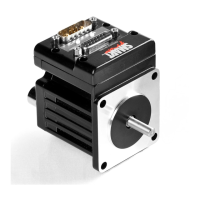Moog Animatics SmartMotor™ Developer's Guide,Rev. L
Page 501 of 909
KI=formula
Constant, Integral Coefficient
APPLICATION: Motion control
DESCRIPTION: Value of buffered integral gain
EXECUTION: Buffered until an F command is issued
CONDITIONAL TO: N/A
LIMITATIONS: Must be positive, total integral limited by KL
READ/REPORT: RKI
WRITE: Read/write
LANGUAGE ACCESS: Assignment, formulas and conditional testing
UNITS: N/A
RANGE OF VALUES: 0 to 32767
TYPICAL VALUES: 0 to 1000
DEFAULT VALUE: Motor-size dependent
FIRMWARE VERSION: 5.x and later
COMBITRONIC: KI:3=1234
where ":3" is the motor address — use the actual address or a
variable
DETAILED DESCRIPTION:
The KI term sets the integral gain of the PID filter. The integral compensator is not for
stability. Raising it too far will cause the motor to become unstable.
NOTE: The motion or servo modifications from this command must be applied by
the F function. For details, see F on page 446.
The KI command is designed to compensate for constant offsets, such as friction in the
system or other constant forces. The amount of effort sent to the motor from the KP term of
the PID is proportional to the distance it is from its target position. Therefore, as the target
gets close, the small position error results in a torque that is too small to allow the motor to
reach the final target. The KI term helps to overcome this limitation by adding up, over a long
period of time, this small but constant error. This ensures that the servo can eventually reach
a position error of 0 at a steady-state speed.
The integral term of the PID filter is generated by taking the sum of the position error of every
sample and then multiplying by KI. By doing this, it creates a force that increases over time
until the error is corrected. This correction occurs at a rate set by the KI parameter.
Therefore, when tuning your motor for stability, it is a good idea to set KI to zero and then
increase it until you see that it reliably compensates your system.
NOTE: KL, the protective upper limit, must be set high enough to allow KI to do its
job.
Part 2: Commands: KI=formula

